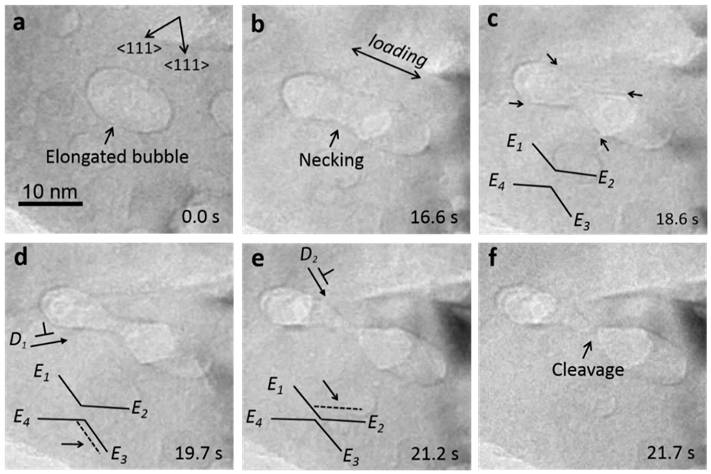Recently, the research team led by Prof.
Weizhong Han (韩卫忠) at the State
Key Laboratory for Mechanical Behavior of Materials, Xi’an Jiaotong University,
uncovered the novel deformation mechanism of helium bubbled copper, which was
published in Nano Letters (2016, 16:4118-4124) and Physical Review Letters (2016, 117:215501).
Helium bubbles are one of the typical radiation microstructures
in metals and alloys, significantly influencing their deformation behavior,
usually causing severe high temperature helium embrittlement in bulk metals. However,
here we found that helium radiation can actually enhance the room-temperature
deformability of submicron-sized single crystal copper. In particular, Cu
single crystals with diameter of 100 nm to 300 nm and containing numerous
pressurized sub-10 nm helium bubbles, become stronger, more stable in plastic
flow and ductile in tension, compared to fully dense samples of the same
dimensions that tend to display plastic instability (strain bursts). The sub-10
nm helium bubbles are seen to be dislocation sources as well as shearable
obstacles, which promote dislocation storage and reduce dislocation mean free
path, thus contributing to more homogeneous and stable plasticity. Failure
happens abruptly only after significant bubble coalescence. This findings was
published in Nano Letters (2016, 16:4117-4124).

Furthermore, the dynamic evolution of helium
bubbles under straining is less explored due to the challenging experimental
setup. Here, by using a new design of the testing sample geometry, we are able
to probe the evolution of singular bubble, and discover that the helium bubble
not only can coalesce with adjacent bubbles, but also can split into several
nanoscale bubbles under tension. Alignment of the splittings along a slip line
can create a bubble-free-channel, which appears softer, promotes shear
localization, and accelerates the failure in shearing-off mode. Detailed
analyses unveil that the unexpected bubble fragmentation is mediated by the
combination of dislocation cutting and internal surface diffusion, which is an
alternative micro-damage mechanism of helium irradiated copper besides the
bubble coalescence, see details in Physical Review Letters (2016,
117:215501). These findings shed new light on the plastic deformation mechanism
of helium irradiated metals.
Links:1. http://pubs.acs.org/doi/abs/10.1021/acs.nanolett.6b00864
2. http://journals.aps.org/prl/abstract/10.1103/PhysRevLett.117.215501


